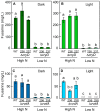Three Genes Involved in Different Signaling Pathways, carS, wcoA, and acyA, Participate in the Regulation of Fusarin Biosynthesis in Fusarium fujikuroi
- PMID: 38535211
- PMCID: PMC10971159
- DOI: 10.3390/jof10030203
Three Genes Involved in Different Signaling Pathways, carS, wcoA, and acyA, Participate in the Regulation of Fusarin Biosynthesis in Fusarium fujikuroi
Abstract
The phytopathogenic fungus Fusarium fujikuroi has a rich secondary metabolism which includes the synthesis of very different metabolites in response to diverse environmental cues, such as light or nitrogen. Here, we focused our attention on fusarins, a class of mycotoxins whose synthesis is downregulated by nitrogen starvation. Previous data showed that mutants of genes involved in carotenoid regulation (carS, encoding a RING finger protein repressor), light detection (wcoA, White Collar photoreceptor), and cAMP signaling (AcyA, adenylate cyclase) affect the synthesis of different metabolites. We studied the effect of these mutations on fusarin production and the expression of the fus1 gene, which encodes the key polyketide synthase of the pathway. We found that the three proteins are positive regulators of fusarin synthesis, especially WcoA and AcyA, linking light regulation to cAMP signaling. Genes for two other photoreceptors, the cryptochrome CryD and the Vivid flavoprotein VvdA, were not involved in fusarin regulation. In most cases, there was a correspondence between fusarin production and fus1 mRNA, indicating that regulation is mainly exerted at the transcriptional level. We conclude that fusarin synthesis is subject to a complex control involving regulators from different signaling pathways.
Keywords: CarS; Fus1 polyketide synthase; Fusarins; White Collar; adenylate cyclase; photoreceptor.
Conflict of interest statement
The authors declare no conflicts of interest.
Figures






Similar articles
-
The flavoproteins CryD and VvdA cooperate with the white collar protein WcoA in the control of photocarotenogenesis in Fusarium fujikuroi.PLoS One. 2015 Mar 16;10(3):e0119785. doi: 10.1371/journal.pone.0119785. eCollection 2015. PLoS One. 2015. PMID: 25774802 Free PMC article.
-
The White Collar protein WcoA of Fusarium fujikuroi is not essential for photocarotenogenesis, but is involved in the regulation of secondary metabolism and conidiation.Fungal Genet Biol. 2008 May;45(5):705-18. doi: 10.1016/j.fgb.2007.12.003. Epub 2007 Dec 15. Fungal Genet Biol. 2008. PMID: 18203635
-
Identification and regulation of fusA, the polyketide synthase gene responsible for fusarin production in Fusarium fujikuroi.Appl Environ Microbiol. 2012 Oct;78(20):7258-66. doi: 10.1128/AEM.01552-12. Epub 2012 Aug 3. Appl Environ Microbiol. 2012. PMID: 22865073 Free PMC article.
-
Fusarium Photoreceptors.J Fungi (Basel). 2023 Mar 4;9(3):319. doi: 10.3390/jof9030319. J Fungi (Basel). 2023. PMID: 36983487 Free PMC article. Review.
-
Carotenoid Biosynthesis in Fusarium.J Fungi (Basel). 2017 Jul 7;3(3):39. doi: 10.3390/jof3030039. J Fungi (Basel). 2017. PMID: 29371556 Free PMC article. Review.
References
-
- Niehaus E.-M., Kim H.-K., Münsterkötter M., Janevska S., Arndt B., Kalinina S.A., Houterman P.M., Ahn I.-P., Alberti I., Tonti S., et al. Comparative Genomics of Geographically Distant Fusarium fujikuroi Isolates Revealed Two Distinct Pathotypes Correlating with Secondary Metabolite Profiles. PLoS Pathog. 2017;13:e1006670. doi: 10.1371/journal.ppat.1006670. - DOI - PMC - PubMed
-
- Janevska S., Arndt B., Niehaus E.-M., Burkhardt I., Rösler S.M., Brock N.L., Humpf H.-U., Dickschat J.S., Tudzynski B. Gibepyrone Biosynthesis in the Rice Pathogen Fusarium fujikuroi Is Facilitated by a Small Polyketide Synthase Gene Cluster. J. Biol. Chem. 2016;291:27403–27420. doi: 10.1074/jbc.M116.753053. - DOI - PMC - PubMed
Grants and funding
LinkOut - more resources
Full Text Sources

